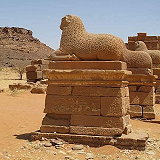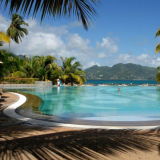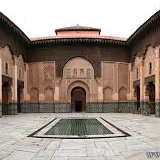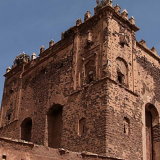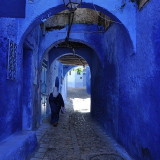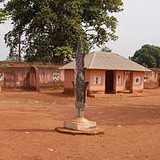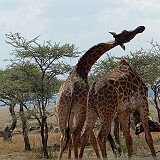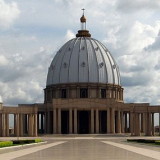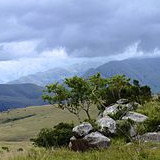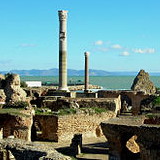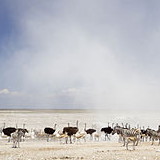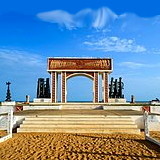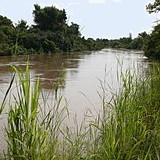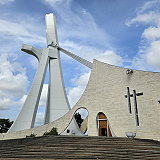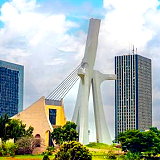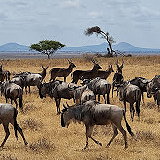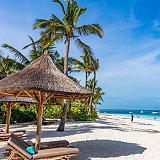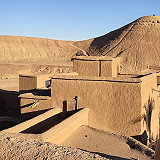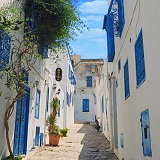| Pyramids of Meroe | |
| The Meroë Pyramids are a large complex of Nubian pyramids, comprising three burial sites near the ancient city of Meroë. Dating from the late Kush Kingdom period (3rd century BC – 4th century AD), the Meroë Pyramids served as burial places for Kush kings, other members of the royal family, and important officials and dignitaries. | |
| Sainte Anne Resort | |
| A five hundred-acre private island paradise surrounded by a national marine park, Sainte Anne Resort & Spa exudes quality in a naturally beautiful setting. Hide away in one of the divine, sea-facing private villas featuring Creole-style décor and furnishings and enjoy outdoor living, gazebos perfect for lazy afternoons sunbathing and palatial bathrooms with fabulous outdoor showers. | |
| Al Attarine Madrasa | |
| The Al-Attarine Madrasa or Medersa al-Attarine is a madrasa in Fes, Morocco, near the Al-Qarawiyyin Mosque. It was built by the Marinid sultan Uthman II Abu Said (r. 1310-1331) in 1323-5. It is considered one of the highest achievements of Marinid architecture due to its rich and harmonious decoration and its efficient use of limited space. | |
| Telouet Kasbah | |
| Telouet Kasbah is a historic fortified palace located in the High Atlas Mountains of Morocco. Built in the 18th and 19th centuries, the kasbah served as the seat of power for the Glaoui family, who were once one of the most powerful families in Morocco. Kasbah Telouet is a Kasbah along the important former trading route of the caravans between Marrakech and the Sahara. | |
| Chefchaouen | |
| Chefchaouen is a picturesque city located in the Rif Mountains of northern Morocco. Known for its blue-washed buildings and stunning natural beauty, Chefchaouen has become a popular destination for tourists seeking a unique and peaceful escape from the hustle and bustle of other Moroccan cities. | |
| Royal Palaces of Abomey | |
| The Royal Palaces of Abomey are 12 palaces spread over an area of 40 hectares (100 acres) at the heart of the Abomey town in Benin, formerly the capital of the West African Kingdom of Dahomey. At its peak the palaces could accommodate up to 8000 people. The King's palace included a two-story building known as the "cowrie house" or akuehue. | |
| Serengeti National Park | |
| Serengeti National Park is a world-renowned wildlife sanctuary located in Tanzania, East Africa. The park covers an area of approximately 14,763 square kilometers (5,700 square miles) and is famous for its spectacular wildlife migrations, which see millions of animals moving across the plains in search of food and water. | |
| Basilica of Our Lady of Peace | |
| The Basilica of Our Lady of Peace is a Catholic minor basilica dedicated to Our Lady of Peace in Yamoussoukro, the administrative capital of Côte d'Ivoire. Guinness World Records lists it as the largest church in the world, having surpassed the previous record holder, Saint Peter's Basilica, upon completion. It has an area of 30,000 square metres (320,000 sq ft) and is 158 metres (518 ft) tall. | |
| Malolotja National Park | |
| Malolotja National Park covers 18,000 hectares or 44,000 acres of mountain wilderness on Eswatini's northwestern border with South Africa. The park includes Ngwenya Mountain, Eswatini's second highest mountain 1,829 m, and Malolotja Falls which drop 89 metres or 292 ft, the highest in Eswatini. Habitats include short grassland to thick riverine scrub, bushveld and Afromontane forest. | |
| Baths of Antoninus | |
| The Baths of Antoninus or Baths of Carthage, located in Carthage, Tunisia, are the largest set of Roman thermae built on the African continent and one of three largest built in the Roman Empire. They are the largest outside mainland Italy. The baths are also the only remaining Thermae of Carthage that dates back to the Roman Empire's era. The baths were built during the reign of Roman Emperor Antoninus Pius. | |
| Etosha National Park | |
| Etosha National Park is a national park located in northwestern Namibia, known for its unique landscape and abundant wildlife. It covers an area of 22,270 km² (8,600 sq mi), making it one of the largest national parks in Africa. The park is home to hundreds of species of mammals, birds, and reptiles, including several threatened and endangered species such as the black rhinoceros. | |
| Door of No Return | |
| The Door of No Return is a memorial arch in Ouidah, Benin. The concrete and bronze arch, which stands on the beach, is a memorial to the enslaved Africans who were taken from the slave port of Ouidah to the Americas. | |
| W National Park | |
| The W National Park or W Regional Park is a major national park in West Africa around a meander in the Niger River shaped like the letter W. The park includes areas of the three countries Niger, Benin and Burkina Faso, and is governed by the three governments. | |
| Sanctuaire Marial | |
| The Sanctuaire Marial, also known as the Marian Shrine, in Abidjan, Côte d'Ivoire, is a significant religious site dedicated to the Virgin Mary. It serves as a place of pilgrimage, prayer, and reflection for the local Catholic community and visitors. As a Marian shrine, it is dedicated to the veneration of the Virgin Mary, who holds a special place in the hearts of many Catholics. | |
| St Paul's Cathedral | |
| St Paul's Cathedral is a Roman Catholic cathedral located in the city of Abidjan, Côte d'Ivoire. The cathedral, which was designed by the Italian architect Aldo Spirito, serves as the mother church for the Roman Catholic Archdiocese of Abidjan. | |
| Abidjan | |
| Abidjan is the largest city and the former capital of Ivory Coast. As of the 2021 census, Abidjan's population was 6.3 million. A cultural crossroads of West Africa, Abidjan is characterised by a high level of industrialisation and urbanisation. It is the most populous French-speaking city in West Africa. | |
| Tarangire National Park | |
| Tarangire National Park is a national park in Tanzania's Manyara Region. The park is most popular for its large elephant herds and mini-wildlife migration that takes place during the dry season which sees about 250,000 animals enter the park. | |
| Unguja | |
| Unguja, also known as Zanzibar Island, is the largest and most populated island of the Zanzibar archipelago, in Tanzania. Unguja is a hilly island, about 85 kilometres (53 miles) long (north-south) and 30 kilometres (19 miles) wide (east-west) at its widest, with an overall area of about 1,666 square kilometres (643 square miles). | |
| Kasbah Ait Ben Haddou | |
| Aït Benhaddou is a historic ighrem or ksar (fortified village) along the former caravan route between the Sahara and Marrakesh in Morocco. It is considered a great example of Moroccan earthen clay architecture. The Ksar of Ait-Ben-Haddou is located in the foothills of the Atlas Mountains, a natural gateway to the desert, 30 km north-west of the Moroccan town of Ouarzazate. | |
| Sidi Bou Said | |
| Sidi Bou Said is a town in northern Tunisia located about 20 km northeast from the capital, Tunis. The town itself is a tourist attraction and is known for its extensive use of blue and white. It can be reached by a TGM train, which runs from Tunis to La Marsa. Its population was 6,000 in 2023. | |
